Ancient history
| Ancient history |
|---|
| Preceded by prehistory |
|
| Part of a series on |
| Human history Human Era |
|---|
| ↑ Prehistory (Stone Age) (Pleistocene epoch) |
| ↓ Future |
Ancient history is a
During the time period of ancient history, the world population was already exponentially increasing due to the Neolithic Revolution, which was in full progress. While in 10,000 BC, the world population stood at 2 million, it rose to 45 million by 3,000 BC. By the Iron Age in 1000 BC, the population had risen to 72 million. By the end of the ancient period in AD 500, the world population is thought to have stood at 209 million. In 10,500 years, the world population increased by 100 times.[1]
Prehistory
Prehistory is the period before written history. Most of our knowledge of that period comes from the work of archaeologists.[2] Prehistory is often known as the Stone Age, and is divided into the Paleolithic (earliest), Mesolithic, and Neolithic.[3]
The
Evidence for
Metal use in the form of hammered
History by region
West Asia
The ancient Near East is considered the
Mesopotamia
Mesopotamia is the site of some of the earliest known civilisations in the world.[29] Agricultural communities emerged in the area with the Halaf culture around 8000 BC and continued to expand through the Ubaid period around 6000 BC.[30] Cities began in the Uruk period (4000–3100 BC) and expanded during the Jemdet Nasr (3100–2900 BC) and Early Dynastic (2900–2350 BC) periods.[31] The surplus of storable foodstuffs created by this economy allowed the population to settle in one place instead of migrating after crops and herds. It also allowed for a much greater population density, and in turn required an extensive labour force and division of labour.[16] This organization led to the necessity of record keeping and the development of writing.[32]
The Neo-Babylonian Empire, or Chaldea, was Babylonia from the 7th and 6th centuries BC.[34] Under the reign of Nebuchadnezzar II, it conquered Jerusalem. This empire also created the Hanging Gardens of Babylon and the still-surviving Ishtar Gate as architectural embellishments of its capital at Babylon.[35]
Akkad was a city and its surrounding region near Babylon. Akkad also became the capital of the Akkadian Empire.[36] Despite an extensive search, the precise site has never been found. Akkad reached the height of its power between about 2330 and 2150 BC, following the conquests of King Sargon of Akkad.[36] Through the spread of Sargon's empire, the language of Akkad, known as Akkadian from the city, spread and replaced the Sumerian language in Mesopotamia and eventually by 1450 BC was the main language of diplomacy in the Near East.[37]
Assyria was originally a region on the Upper Tigris, where a small state was created in the 19th century BC.[34] The capital was at Assur, which gave the state its name.[38] Later, as a nation and empire that came to control all of the Fertile Crescent, Egypt and much of Anatolia, the term "Assyria proper" referred to roughly the northern half of Mesopotamia (the southern half being Babylonia), with Nineveh as its capital. The Assyrian kings controlled a large kingdom at three different times in history. These are called the Old (20th to 18th centuries BC), Middle (14th to 11th centuries BC), and Neo-Assyrian (9th to 7th centuries BC) kingdoms, or periods.[39]
Mitanni was a Hurrian empire in northern Mesopotamia founded around 1500 BC. The Mitanians conquered and controlled Assyria until the 14th century BC while contending with Egypt for control of parts of modern Syria. Its capital was Washukanni, whose precise location has not been determined by archaeologists.[40]
Iranian peoples
The
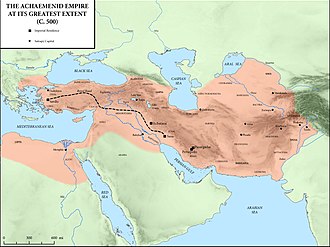
The Achaemenid Empire was founded by Cyrus the Great, who first became king of the Persians, then conquered the Medes, Lydia, and Babylon by 539 BC. The empire built on earlier Mesopotamian systems of government to govern their large empire. By building roads, they improved both the ability to send governmental instructions throughout their lands as well as improving the ability of their military forces to be deployed rapidly. Increased trade and upgraded farming techniques increased wealth, but also exacerbated inequalities between social classes. The empire's location at the centre of trading networks spread its intellectual and philosophical ideas throughout a wide area, and its religion, while not itself spreading far, had an impact on later religions such as Christianity, Islam, and Judaism.[42] Cyrus' son Cambyses II conquered Egypt, while a later emperor, Darius the Great, expanded the empire to the Indus River, creating the largest empire in the world to that date.[43] But Darius and his son Xerxes I failed to expand into Greece, with expeditions in 490 and 480 BC eventually failing.[44] The Achaemenid dynasty and empire fell to Alexander the Great by 330 BC, and after Alexander's death, much of the area previously ruled by the Cyrus and his successors was ruled by the Seleucid dynasty.[45]

The Sasanian Empire began when the Parthian Empire ended in AD 224. Their rulers claimed the Achaemenids as ancestors and set up their capital at Ctesiphon in Mesopotamia. Their period of greatest military expansion occurred under Shapur I, who by the time of his death in AD 272 had defeated Roman imperial armies and set up buffer states between the Sasanians and Roman Empires. After Shapur, the Sasanians were under more pressure from the Kushans to their east as well as the Roman then Byzantine Empire to its west. However, the Sasanians rebuilt and founded numerous cities and their merchants traveled widely and introduced crops such as sugar, rice, and cotton into the Iranian plateau. But in AD 651, the last Sassanid emperor was killed by the expanding Islamic Arabs.[47]
Hittites
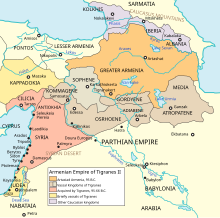
The
Israel

Israel had emerged by the middle of the 9th century BC, when the Assyrian King Shalmaneser III named "Ahab the Israelite" among his enemies at the battle of Qarqar (853). Judah emerged somewhat later than Israel, probably during the 9th century BC, but the subject is one of considerable controversy.[52] Israel came into conflict with the Assyrians, who conquered Israel in 722 BC. The Neo-Babylonian Empire did the same to Judah in 586. After both conquests, the conquering forces deported many of the inhabitants to other regions of their respective empires.[53]
Following the fall of Babylon to the Persian Empire, Cyrus the Great allowed the rebuilding of the temple at
Phoenicia
Arabia
The history of Pre-Islamic Arabia before the rise of
Africa
Afro-Asiatic Africa
Carthage
Carthage was founded around 814 BC by Phoenician settlers.[58] Ancient Carthage was a city-state that ruled an empire through alliances and trade influence that stretched throughout North Africa and modern Spain.[61] At the height of the city's influence, its empire included most of the western Mediterranean.[58] The empire was in a constant state of struggle with the Roman Republic, which led to a series of conflicts known as the Punic Wars. After the third and final Punic War, Carthage was destroyed and then occupied by Roman forces. Nearly all of the territory held by Carthage fell into Roman hands.[62]
Egypt
Ancient Egypt was a long-lived civilisation geographically located in north-eastern Africa. It was concentrated along the middle to lower reaches of the Nile River,
Ancient Egypt developed over at least three and a half
Ancient Egyptian history is divided across various periods, beginning with the
Nubia

The Ta-Seti kingdom in Nubia to the south of Egypt was conquered by Egyptian rulers around 3100 BC, but by 2500 BC the Nubians had created a new kingdom further south, known as the Kingdom of Kush, centred on the upper Nile with a capital at Kerma.[77] In the Egyptian New Kingdom period, Kush once more was conquered by Egypt. However, by 1100 BC a new kingdom of Kush had formed, with a capital at Napata. Nubian rulers conquered Egypt around 760 BC and retained control for about a century.[78]
Aksum and ancient Ethiopia

The Kingdom of Aksum was an important trading nation in northeastern Africa centered in present-day Eritrea and northern Ethiopia, it existed from approximately AD 100 to 940, growing from the Iron Age proto-Aksumite period around the 4th century BC to achieve prominence by the 1st century AD.[79] The Kingdom of Aksum at its height by the early 6th-century AD extended through much of modern Ethiopia and across the Red Sea to Arabia. The capital city of the empire was Aksum, now in northern Ethiopia.[80]
Niger-Congo Africa
Nok culture
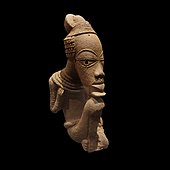
The Nok culture appeared in Nigeria around 1000 BC and mysteriously vanished around AD 200. The civilisation's social system is thought to have been highly advanced. The Nok civilisation was considered to be the earliest sub-Saharan producer of life-sized Terracotta which have been discovered by archaeologists. The Nok also used iron smelting that may have been independently developed.[81]
Sahel
Djenné-Djenno
The civilisation of Djenné-Djenno was located in the Niger River Valley in the country of Mali and is considered to be among the oldest urbanized centers and the best-known archaeology site in sub-Saharan Africa. This archaeological site is located about 3 kilometers (1.9 miles) away from the modern town and is believed to have been involved in long-distance trade and possibly the domestication of African rice. The site is believed to exceed 33 hectares (82 acres); however, this is yet to be confirmed with extensive survey work. With the help of archaeological excavations mainly by Susan and Roderick McIntosh, the site is known to have been occupied from 250 BC to AD 900. The city is believed to have been abandoned and moved where the current city is located due to the spread of Islam and the building of the Great Mosque of Djenné. Previously, it was assumed that advanced trade networks and complex societies did not exist in the region until the arrival of traders from Southwest Asia. However, sites such as Djenné-Djenno disprove this, as these traditions in West Africa flourished long before. Towns similar to that at Djenne-Jeno also developed at the site of Dia, also in Mali along the Niger River, from around 900 BC.
Dhar Tichitt and Oualata
Dhar Tichitt and Oualata were prominent among the early urban centres, dated to 2000 BC, in present-day Mauritania. About 500 stone settlements littered the region in the former savannah of the Sahara. Its inhabitants fished and grew millet. It has been found that the Soninke of the Mandé peoples were responsible for constructing such settlements. Around 300 BC, the region became more desiccated and the settlements began to decline, most likely relocating to Koumbi Saleh. From the type of architecture and pottery, it is believed that Tichit was related to the subsequent Ghana Empire. Old Jenne (Djenne) began to be settled around 300 BC, producing iron and with sizeable population, evidenced in crowded cemeteries. The inhabitants and creators of these settlements during these periods are thought to have been ancestors of the Soninke people.
Bantu expansion
Peoples speaking precursors to the modern-day Bantu languages began to spread throughout southern Africa, and by 2000 BC they were expanding past the Congo River and into the Great Lakes area. By AD 1000 these groups had spread throughout all of southern Africa south of the equator.[82] Iron metallurgy and agriculture spread along with these peoples, with the cultivation of millet, oil palms, sorghum, and yams as well as the use of domesticated cattle, pigs, and sheep. These technologies helped increase population, and settled communities became common in sub-Saharan Africa except in deserts or heavy forests.[83]
South Asia
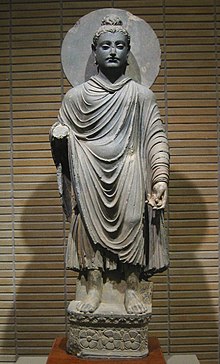
The Indus Valley civilization developed around 3000 BC in the
Indo-European speaking peoples began to spread into India about 1500 BC. The
The kingdom of
Most of
East Asia
China
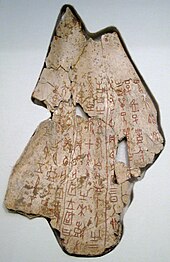
The Chinese civilisation that emerged within the
The Shang dynasty traditionally is dated to 1766 to 1122 BC. Bronze was central to Shang culture and technology, with chariots and bronze weapons helping to expand Shang control over northern China. The cities at Ao and Yinxu, near Anyang, have been excavated and city walls, royal palaces, and archives as well as tombs and workshops were found.[104] A system of writing developed, beginning with oracle bones, of which over 100,000 are still extant.[105]
Towards the end of the 2nd millennium BC, the Shang were overrun by the Zhou dynasty from the Wei River valley to the west. The Zhou rulers at this time invoked the concept of the Mandate of Heaven to legitimize their rule, a concept that would be influential for almost every successive dynasty. The Zhou initially established their capital in the west near modern Xi'an, near the Yellow River, but they would preside over a series of expansions into the Yangtze River valley. Zhou administration was decentralised, with local elites responsible for collecting tribute and providing military support to the Zhou rulers.[106]
In the 8th century BC, power became decentralized during the Spring and Autumn period,[107] named after the influential Spring and Autumn Annals.[108] In this period, local military leaders used by the Zhou began to assert their power and vie for hegemony.[107] The situation was aggravated by the invasion of other peoples,[109] forcing the Zhou to move their capital east to Luoyang.[110] In each of the hundreds of states that eventually arose, local strongmen held most of the political power and continued their subservience to the Zhou kings in name only. The Hundred Schools of Thought of Chinese philosophy blossomed during this period, and such influential intellectual movements as Confucianism, Taoism, Legalism and Mohism were founded, partly in response to the changing political world.[111][112]
After further political consolidation, seven prominent states remained by the end of the 5th century BC, and the years in which these few states battled each other is known as the Warring States period.[113] Though there remained a nominal Zhou king until 256 BC, he was largely a figurehead and held little power.[114] As neighboring territories of these warring states, including areas of modern Sichuan and Liaoning, were annexed by the growing power of the rulers of Qin,[115] they were governed under the new local administrative system of commandery.[116] The final expansion in this period began during the reign of Ying Zheng, the king of Qin. His unification of the other six powers, and further annexations to the south and southeast by 213 BC enabled him to proclaim himself the First Emperor (Qin Shi Huangdi).[117]
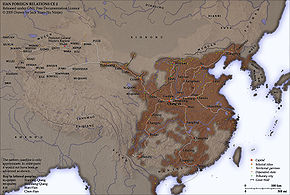
Qin Shi Huangdi ruled the unified China directly with absolute power. In contrast to the decentralized and feudal rule of earlier dynasties the Qin ruled directly. Nationwide the philosophy of
Neighbours of China
The East Asian nations adjacent to China were all profoundly influenced by their interactions with
In 108 BC, the Han dynasty of China conquered much of Korea but when Han China began its decline, three kingdoms in Korea – those of Baekje, Goguryeo and Silla – emerged and expelled the Chinese. Goguryeo and Baekje were eventually destroyed by a Tang dynasty and Silla alliance. Silla then drove out the Tang dynasty in 676 to control most of the Korean peninsula undisputed.[126]
Americas
In pre-Columbian times, several large, centralized ancient civilisations developed in the Western Hemisphere, both in Mesoamerica and western South America.[128] Beyond these areas, the use of agriculture expanded East of the Andes Mountains in South America particularly with the Marajoara culture,[citation needed] and in the continental United States.[129]
Andean civilisations
Ancient Andean civilisation began with the rise of organized fishing communities from 3500 BC onwards. Along with a sophisticated maritime society came the construction of large monuments, which likely existed as community centers.
After the decline of Chavin culture, a number of cities formed after about 200 BC. The cities at
Mesoamerica

Agricultural cultivation began around 8000 BC in Mesoamerica, where avocados, beans, chili peppers, gourds, and squashes were grown from about 7000 BC. Around 4000 BC maize began to be grown, and soon after this tomatoes. Settlements appeared around 3000 BC and by 2000 BC most of Mesoamerica was practicing agriculture. Although some animals were domesticated — notably turkeys and dogs — the lack of suitable large animals precluded the development of animals used for transportation or labour.[134]
Around 1200 BC the first
After the decline of the Olmecs, other civilisations in Mesoamerica either arose or emerged from the Olmec shadow - the
Northern America
Organized societies, in the ancient United States or Canada, were often mound builder civilisations. One of the most significant of these was the Poverty Point culture that existed in the U.S. state of Louisiana, and was responsible for the creation of over 100 mound sites. The Mississippi River was a core area in the development of long-distance trade and culture. Following Poverty Point, successive complex cultures such as the Hopewell emerged in the Southeastern United States in the Early Woodland period. Before AD 500 many mound builder societies retained a hunter gatherer form of subsistence.
Oceania
Humans spread to
Europe
Greece
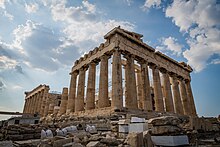
Greece is home to the first advanced civilizations in Europe beginning with the
The Archaic Period in Greece is generally considered to have lasted from around the 8th century BC to the invasion by Xerxes in 480 BC. This period saw the expansion of the Greek world around the Mediterranean, with the founding of Greek city-states as far afield as Sicily in the west and the Black Sea in the east.[147] Politically, the Archaic period in Greece saw the collapse of the power of the old aristocracies, with democratic reforms in Athens and the development of Sparta's unique constitution. The end of the Archaic period also saw the rise of Athens, which would come to be a dominant power in the Classical Period, after the reforms of Solon and the tyranny of Pisistratus.[148]
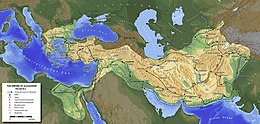
The Classical Greek world was dominated throughout the 5th century BC by the major powers of
Rome
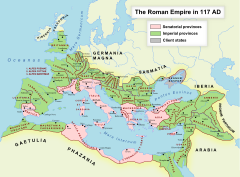
A number of factors led to the eventual
Late antiquity
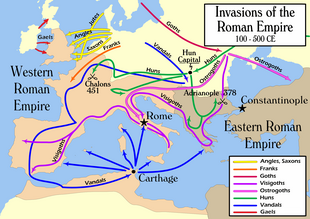
The Roman Empire underwent considerable social, cultural and organizational change starting with reign of
Nomads and Iron Age peoples
The Celts were a diverse group of
The Huns were a nomadic people who formed a large state in Eastern Europe by about AD 400, and under their leader Attila, they fought against both sections of the Roman Empire. However, after Attila's death, the state fell apart and the Huns' influence in history disappeared.[166] The Hun-Xiongnu connection is controversial at best and is often disputed but is also not completely discredited.[167][168]
Migration of Germanic peoples to Britain from what is now northern Germany and southern Scandinavia is attested from the 5th century.[169] Groups of Goths migrated into western Europe, with the Ostrogoths eventually settling in Italy before being conquered by the Lombards.[170] A related people, the Visigoths, settled in Spain, founding a kingdom that lasted until it was conquered by Islamic rulers in the AD 700s.[169]
Developments
Religion and philosophy
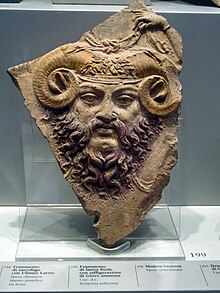
The rise of civilisation corresponded with the institutional sponsorship of belief in gods, supernatural forces and the afterlife.
In the east, three schools of thought were to dominate Chinese thinking until the modern day. These were
In the west, the Greek philosophical tradition, represented by
Science and technology
|
Ancient technological progress began before the recording of history, with tools, use of fire,[177] domestication of animals, and agriculture all predating recorded history.[178] The use of metals and the ability to make metal alloys was foundational for later technologies to develop.[179] Medical knowledge, including the use of herbs to treat illnesses and wounds as well as some surgical techniques, advanced during antiquity.[180] An early very important development that allowed for further advancement was writing, which allowed humans to record information for later use.[181]
The characteristics of ancient Egyptian technology are indicated by a set of artifacts and customs that lasted for thousands of years. The Egyptians invented and used many basic machines, such as the ramp and the lever, to aid construction processes. The Egyptians also played an important role in developing Mediterranean maritime technology, including ships.[182] The Babylonians and Egyptians were early astronomers who recorded their observations of the night sky.[183]
Water managing
The Hindu–Arabic numeral system with the concept of zero was developed in India,[185] while modern forms of paper were invented in China in the first century AD.[186]
See also
References
Citations
- ^ Data Archived 2019-12-10 at the Wayback Machine from History Database of the Global Environment. Archived 2018-02-27 at the Wayback Machine K. Klein Goldewijk, A. Beusen and P. Janssen, "HYDE 3.1: Long-term dynamic modeling of global population and built-up area in a spatially explicit way", from table on p. 2, Netherlands Environmental Assessment Agency (MNP), Bilthoven, The Netherlands.
- ^ Parker 2017, p. 16.
- ^ Roberts & Westad 2013, pp. 22–31.
- ^ Hart-Davis 2012, p. 18.
- ^ Hart-Davis 2012, p. 17.
- ^ Wiesner-Hanks 2015, p. 19.
- ^ a b Wiesner-Hanks 2015, p. 26.
- ^ a b Hart-Davis 2012, p. 19.
- ^ Parker 2017, pp. 36–37.
- ^ a b Wiesner-Hanks 2015, pp. 45–46.
- ^ Parker 2017, p. 44.
- ^ Wiesner-Hanks 2015, pp. 48–49.
- ^ Wiesner-Hanks 2015, p. 54.
- ^ Parker 2017, p. 45.
- ^ a b c d Wiesner-Hanks 2015, pp. 55–56.
- ^ a b Hart-Davis 2012, p. 38.
- ^ Roberts & Westad 2013, pp. 59–60.
- ^ a b c Parker 2017, pp. 60–61.
- ^ Diamond 1999, p. 218.
- ^ a b c Hart-Davis 2012, p. 58.
- ^ Hart-Davis 2012, pp. 60–61.
- ^ Hart-Davis 2012, p. 63.
- ^ a b Hart-Davis 2012, pp. 54–55.
- ^ Parker 2017, pp. 54–55.
- ^ a b Wiesner-Hanks 2015, p. 74.
- ^ Parker 2017, pp. 55–56.
- ^ Wiesner-Hanks 2015, p. 73.
- ^ Roberts & Westad 2013, p. 65.
- ^ Parker 2017, p. 54.
- ^ Hart-Davis 2012, p. 54.
- ^ Emberling 2015, pp. 256–257.
- ^ Wiesner-Hanks 2015, p. 79-80.
- ^ a b Roberts & Westad 2013, p. 63.
- ^ a b Bentley & Ziegler 2006, p. 38.
- ^ a b Roberts & Westad 2013, p. 110.
- ^ a b Bentley & Ziegler 2006, p. 36.
- ^ Bertram 2003, p. 143.
- ^ Bertram 2003, p. 10.
- ^ Hart-Davis 2012, p. 80.
- ^ Hart-Davis 2012, p. 78.
- ^ Bentley & Ziegler 2006, p. 55.
- ^ a b Bentley & Ziegler 2006, pp. 160–161.
- ^ Bentley & Ziegler 2006, p. 162.
- ^ Bentley & Ziegler 2006, p. 165.
- ^ Bentley & Ziegler 2006, p. 166.
- ^ a b Bentley & Ziegler 2006, p. 167.
- ^ Bentley & Ziegler 2006, p. 168.
- ^ Bentley & Ziegler 2006, pp. 53–54.
- ^ Parker 2017, p. 57.
- ^ Stager 1998, p. 91.
- ^ Dever 2003, p. 206.
- ^ Grabbe 2008, pp. 225–226.
- ^ Bentley & Ziegler 2006, p. 47.
- ^ Roberts & Westad 2013, p. 156.
- ^ Bentley & Ziegler 2006, p. 48.
- ^ Roberts & Westad 2013, pp. 248–249.
- ^ Bentley & Ziegler 2006, pp. 48–49.
- ^ a b c Parker 2017, p. 58.
- ^ Parker 2017, p. 49–51.
- ^ a b Roberts & Westad 2013, p. 338.
- ^ Roberts & Westad 2013, pp. 212–213.
- ^ Bentley & Ziegler 2006, p. 264.
- ^ a b Parker 2017, pp. 62–63.
- ^ a b Parker 2017, pp. 68–69.
- ^ Hart-Davis 2012, p. 64.
- ^ Bentley & Ziegler 2006, p. 63.
- ^ Bentley & Ziegler 2006, p. 62.
- ^ Bentley & Ziegler 2006, p. 73.
- ^ Bentley & Ziegler 2006, p. 75.
- ^ Hart-Davis 2012, pp. 72–73.
- ^ Bentley & Ziegler 2006, pp. 73–74.
- ^ Bentley & Ziegler 2006, pp. 77–78.
- ^ Bentley & Ziegler 2006, pp. 70–71.
- ^ Hart-Davis 2012, pp. 56–57.
- ^ Parker 2017, p. 62.
- ^ Parker 2017, p. 66.
- ^ Bentley & Ziegler 2006, pp. 64–66.
- ^ Bentley & Ziegler 2006, pp. 67–69.
- ^ Phillipson 2012, p. 48.
- ^ Munro-Hay 1991, p. 57.
- ^ Shaw 1978.
- ^ Bentley & Ziegler 2006, p. 81.
- ^ Bentley & Ziegler 2006, pp. 82–83.
- ^ a b c Bentley & Ziegler 2006, p. 87.
- ^ Parker 2017, p. 43.
- ^ Parker 2017, p. 74.
- ^ a b Bentley & Ziegler 2006, p. 89.
- ^ Parker 2017, p. 75.
- ^ Bentley & Ziegler 2006, p. 92.
- ^ Bentley & Ziegler 2006, p. 94.
- ^ Bentley & Ziegler 2006, p. 95.
- ^ Bentley & Ziegler 2006, pp. 96–97.
- ^ a b Parker 2017, p. 122.
- ^ Parker 2017, p. 123.
- ^ Mendis 1999, p. 11.
- ^ Wijesooriya 2006, p. 34.
- ^ Bentley & Ziegler 2006, p. 212.
- ^ Bentley & Ziegler 2006, p. 213.
- ^ Parker 2017, p. 52.
- ^ Parker 2017, p. 76.
- ^ Hart-Davis 2012, p. 60.
- ^ Bentley & Ziegler 2006, p. 111.
- ^ Bentley & Ziegler 2006, p. 112.
- ^ Bentley & Ziegler 2006, pp. 113–114.
- ^ Bentley & Ziegler 2006, pp. 121–125.
- ^ Bentley & Ziegler 2006, pp. 115–116.
- ^ a b Roberts & Westad 2013, pp. 132–133.
- ^ Gernet 1996, p. 53.
- ^ Bentley & Ziegler 2006, p. 128.
- ^ Bentley & Ziegler 2006, p. 118.
- ^ Roberts & Westad 2013, pp. 133–135.
- ^ a b Bentley & Ziegler 2006, pp. 182–189.
- ^ Gernet 1996, pp. 62–63.
- ^ Bentley & Ziegler 2006, p. 119.
- ^ Bentley & Ziegler 2006, p. 190.
- ^ Gernet 1996, p. 106.
- ^ Roberts & Westad 2013, p. 313-.
- ^ Bentley & Ziegler 2006, pp. 190–192.
- ^ Bentley & Ziegler 2006, pp. 193–194.
- ^ Bentley & Ziegler 2006, pp. 197–198.
- ^ Bentley & Ziegler 2006, pp. 200–203.
- ^ Rawson 1999.
- ^ "Shaanxi History Museum notice". Shaanxi History Museum. Archived from the original on 14 January 2021. Retrieved 18 October 2020.
- ^ Bentley & Ziegler 2006, pp. 195–196.
- ^ Bentley & Ziegler 2006, pp. 196–197.
- ^ Parker 2017, p. 150.
- ^ Parker 2017, p. 144.
- ^ Parker 2017, p. 78.
- ^ Bentley & Ziegler 2006, p. 548.
- ^ jseagard (2 February 2011). "Proyecto Arqueológico Norte Chico". Field Museum. Archived from the original on 10 March 2020. Retrieved 14 March 2019.
- ^ a b Bentley & Ziegler 2006, pp. 146–147.
- ^ Bentley & Ziegler 2006, pp. 147–148.
- ^ Parker 2017, p. 131.
- ^ Bentley & Ziegler 2006, p. 135.
- ^ Bentley & Ziegler 2006, pp. 136–138.
- ^ Parker 2017, pp. 128–129.
- ^ Parker 2017, p. 129.
- ^ Parker 2017, p. 128.
- ^ Parker 2017, p. 130.
- ^ Bentley & Ziegler 2006, pp. 137–141.
- ^ Bentley & Ziegler 2006, p. 148.
- ^ Bentley & Ziegler 2006, pp. 149–150.
- ISBN 9781444358773.
- ISBN 978-1-57607-800-6. Retrieved 5 December 2012.
People appear to have first entered Greece as hunter-gatherers from southwest Asia about 50,000 years... of Bronze Age culture and technology laid the foundations for the rise of Europe's first civilization, Minoan Crete
- ^ ISBN 978-0-7614-7902-4. Retrieved 5 December 2012.
Greece was home to the earliest European civilizations, the Minoan civilization of Crete, which developed around 2000 BC, and the Mycenaean civilization on the Greek mainland, which emerged about 400 years later
- ISBN 0691025916.
- ^ Boardman & Hammond 1970, p. xiii.
- ^ Boardman & Hammond 1970, p. xv.
- ^ Lewis et al. 1992, pp. xiii–xiv.
- ^ Hart-Davis 2012, p. 99.
- ^ Parker 2017, p. 98.
- ^ Hart-Davis 2012, pp. 98–99.
- ^ Hart-Davis 2012, pp. 106–107.
- ^ Parker 2017, p. 101.
- ^ Parker 2017, pp. 102–103.
- ^ Hart-Davis 2012, pp. 110–111.
- ^ Parker 2017, pp. 104–105.
- ^ Hart-Davis 2012, pp. 110–113.
- ^ Parker 2017, p. 113.
- ^ Hart-Davis 2012, pp. 198–199.
- ^ a b Hart-Davis 2012, pp. 150–151.
- ^ Parker 2017, pp. 110–111.
- ^ Parker 2017, p. 112.
- ISSN 2470-2048.
- ^ Parker 2017, p. 114.
- ^ Parker 2017, p. 111.
- ^ Wright 2011, p. 60.
- ^ de la Vaissière 2015, p. 188.
- ^ a b Parker 2017, p. 163.
- ^ Parker 2017, p. 162.
- ^ Hart-Davis 2012, pp. 40–41.
- ^ Hart-Davis 2012, pp. 142–143.
- ^ a b Hart-Davis 2012, pp. 144–147.
- ^ Bentley & Ziegler 2006, p. 396.
- ^ Bentley & Ziegler 2006, p. 397.
- ^ Hart-Davis 2012, pp. 130–131.
- ^ Hart-Davis 2012, pp. 24–29.
- ^ Hart-Davis 2012, pp. 36–37.
- ^ Hart-Davis 2012, pp. 42–43.
- ^ Hart-Davis 2012, pp. 52–53.
- ^ Hart-Davis 2012, pp. 62–63.
- ^ Shaw 2012, pp. 117–119.
- ^ Hart-Davis 2012, p. 104.
- ^ Wilson 2008, pp. 292–293.
- ^ Bentley & Ziegler 2006, p. 225.
- ^ Hart-Davis 2012, p. 129.
Sources
- ISBN 978-0-07-299827-6.
- Bertram, Stephen (2003). Handbook to Life in Ancient Mesopotamia. Oxford: ISBN 978-0-19-518364-1.
- ISBN 978-0-521-23447-4.
- ISBN 978-1-107-63388-9.
- ISBN 978-0-8028-0975-9.
- Diamond, Jared (1999). Guns, Germs, and Steel: The Fates of Human Societies. New York: W. W. Norton & Company.
- Emberling, Geoff (2015). "Mesopotamian cities and urban process, 3500–1600 BCE". In Yoffee, Norman (ed.). The Cambridge World History: Volume III: Early Cities in Comparative Perspective, 4000 BCE–1200 CE. Cambridge: ISBN 978-0-521-19008-4.
- Gernet, Jacques (1996). A History of Chinese Civilization. Translated by Foster, J. R.; Hartman, Charles (Second ed.). Cambridge: ISBN 978-0-521-49781-7.
- Grabbe, Lester L., ed. (2008). Israel in Transition: From Late Bronze II to Iron IIa (c. 1250–850 B.C.E.). ISBN 978-0-567-02726-9.
- ISBN 978-0-7566-7609-4.
- Lewis, D.M.; Boardman, John; Davies, J.K.; et al., eds. (1992). "Preface". The Cambridge Ancient History Volume V: The Fifth Century B.C. ISBN 978-0-521-23347-7.
- Mendis, Ranjan Chinthaka (1999). The Story of Anuradhapura. Kotte: Lakshmi Mendis. ISBN 978-955-96704-0-7.
- Munro-Hay, Stuart (1991). Aksum: An African Civilization of Late Antiquity. Edinburgh: ISBN 978-0-7486-0106-6.
- Parker, Philip (2017). World History: From the Ancient World to the Information Age (Revised ed.). New York: ISBN 978-1-4654-6240-4.
- ISBN 978-0-19-973921-9. Archivedfrom the original on 30 July 2022. Retrieved 11 June 2022.
- Rawson, Jessica (1999). "Design Systems in Early Chinese Art". Orientations: 52. Archived from the original on 18 October 2020. Retrieved 18 October 2020.
- Roberts, J. M.; Westad, Odd Arne (2013). The Penguin History of the World (Sixth ed.). New York: ISBN 978-1-84614-443-1.
- Shaw, Ian (2012). Ancient Egyptian technology and Innovation: Transformations in Pharaonic Material Culture. London: ISBN 978-1-4725-1959-7.
- Shaw, Thurstan (1978). Nigeria: Its Archaeology and Early History. London: ISBN 978-0-500-02086-9.
- Stager, Lawrence E. (1998). "Forging an Identity: The Emergence of Ancient Israel". In Coogan, Michael D. (ed.). The Oxford History of the Biblical World. ISBN 978-0-19-513937-2.
- ISBN 978-1-107-69453-8.
- Wijesooriya, S. (2006). A Concise Sinhala Mahavamsa. Kotte: Participatory Development Forum. ISBN 978-955-9140-31-3.
- ISBN 978-0-19-973485-6.
- Wright, David Curtis (2011). The History of China (2nd ed.). Santa Barbara: ISBN 978-0-313-37748-8.
Further reading
- Hodges, Henry; Newcomer, Judith (1992). Technology in the Ancient World. Barnes & Noble. ISBN 978-0-88029-893-3.
- Kinzl, Konrad H. (1998). Directory of Ancient Historians in the USA, 2nd ed. Claremont, Calif.: Regina Books. ISBN 978-0-941690-87-4. Archived from the originalon 15 February 2010. Retrieved 24 February 2008. Web edition is constantly updated.
- Toffteen, Olaf Alfred (1907). Ancient Chronology. University of Chicago Press.
- Thomas, Carol G.; D.P. Wick (1994). Decoding Ancient History: A Toolkit for the Historian as Detective. Englewood Cliffs, N.J.: Prentice Hall. ISBN 978-0-13-200205-9.
External links
Websites
- World History Encyclopedia
- Ancient Civilizations – British Museum's website on various topics of ancient civilisation
- Ancient history sourcebook
- The Perseus digital library
- Barrington Atlas of the Greek and Roman world
Directories
- Ancient_history at Curlie
- Ancient History – Academic Info: directory of online resources for the study of ancient history.
- Ancient History Resources : Ancient history research links for high school and college students.
